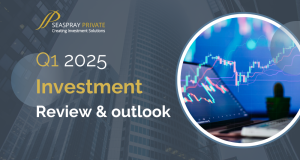2020 Chapter 4…
The 2020 journey so far has been an extremely interesting and memorable one from the point of view of investment markets and for those invested for the long run. After a very volatile first quarter, in which the world we knew underwent some massive changes in a very short period of time, we saw the fastest bear market in the history of global equities followed by record levels of fiscal and monetary support from governments and central banks alike. This stimulus fueled a short sharp bounce from the lows in March, reminding us all of the great importance of remaining invested during times of increased volatility, no matter how grim newspaper headlines and market commentary may appear to be. Had you crystalized your losses in late March when markets were falling rapidly, it is vital to note that while you would have suffered the drawdown, you would have subsequently missed out on the fastest 50-day advance in market history during Q2.
Markets are a forward-looking tool and rallied during the second quarter on hopes for a recovery as lockdowns were eased and economies began their respective reopening processes, driven higher still by an oversold investor sentiment and the aforementioned record levels of stimulus.
The rally eased off as we traded through Q3, with many regions seeing sideways or even slightly negative trade over the three-month period. At a glance, it is easy to assume that the broad market has continued to rally into all-time highs, and that markets have remained optimistic about a return to normal just around the corner. We would like to take this opportunity to remind clients that this is not necessarily the case. If we break down regional performances on a year to date basis (seen in the chart below), we see that performance has actually been quite narrow in the broad market. Indices in the United States have been dragged higher by a handful of large household tech names, many of which have very high weightings in the S&P 500, the vast majority of companies within this highly viewed index still remain in negative territory year to date, on a path similar to European indices.

Similarly, if we break down performance by sector (see chart below), it is obvious that the broad market has not been rallying through all-time highs, rather this rally in certain markets has been led by one or two isolated industries which have gained hugely from the crisis.
It is our view at Seaspray that this broad underperformance during 2020 presents us with opportunities in certain sectors. We believe that on a Global basis, companies that are active and innovative in the field of Artificial Intelligence (AI) should outperform as advanced technology becomes an even more important feature across a wide variety of sectors from telecommunications and manufacturing, healthcare energy and agriculture. According to research from Accenture, by 2035 AI has the power to increase global productivity by 40% or more. The vast majority of our views in 2020 so far have played out in markets, and we are conscious that to sit on the sidelines during the fourth quarter would cause us to miss further opportunity- which the market is constantly presenting us all with as long as we are willing to look in the right places.

As we move through Q4, our daily news will continue to be filled with Covid-19 developments and vaccine news, Europe’s second wave and restrictions and as a result- continued social and economic uncertainties, Biden v Trump debates and election volatility, US-China flareups and tensions, and of course the prospect of a no-deal Brexit at the end of December. With all the noise outlined above (and lots more!), volatility is once again rising and is providing us with longer-term chances to enter the market on a tactical and sector-specific basis. We are of the belief that Presidents, crises, trade tensions all come and go, but fiscal and monetary stimulus will continue to be the main driver of equity markets in years to come as we emerge from the pandemic and return to what once was. We believe that authorities across the globe will continue to provide funds where they are needed, and as a consequence will underpin equity markets in the near to medium term. With this in mind, we believe it prudent to take advantage of some of the volatility that we have seen in recent weeks, and that we should continue to see throughout October and early November.
Equities
It is our in-house view that the global market is currently in the early recovery phase of the cycle following the COVID-19 recession. This implies a period of low-inflation for now, low-interest-rate growth – an environment that usually favours equities over bonds. But after such a rapid rebound, an equity market pullback of the broad market would not be surprising. Technology stock valuations are elevated, with a narrow focus on the top 5 stocks : Facebook, Amazon, Netflix, Google and Nvidia (see below) and the U.S. federal elections create some uncertainties around tax changes, government regulations and the re-escalation of US-China trade tensions.

Beyond this, in the medium term, the market looks set for a rotation away from technology/growth leadership toward cyclical/value stocks. This also implies a rotation toward non-US stocks with Europe and emerging markets the main beneficiaries. We expect that the early-cycle economy will trump later-cycle valuations for the next year or two. The turning point could occur when economies hit full capacity. This will be when unemployment has fallen as far as possible and inflation pressures start to rise. Central banks will likely signal that higher interest rates are on the way and bond yields will move higher in anticipation of this. The pandemic-driven decline in U.S. bond yields below 1% has allowed equity markets to trade at more expensive valuations in terms of price-to-earnings ratios. Rising bond yields will eventually place lofty equity market valuations under pressure but that is still some years away in our view.

Despite seeing their first down-month since March, global equities and especially in the US have made up significant ground since their March lows. We see COVID-19 vaccines and therapeutics as a key driver moving forward. Positive vaccine progress during the fourth quarter could further boost stocks, particularly those at the epicenter of coronavirus pain. Examples include travel and leisure broadly and select retailers. While the unprecedented vaccine effort has required significant government outlay, the money spent pales relative to expected economic losses. Alongside the ongoing battle with the pandemic and its economic fallout is a pivotal U.S. election. Volatility historically has trended higher as elections near, and this year is likely to be more pronounced. It would not surprise us to see a contested election that drags on, exacerbating volatility through December.
What we have to understand from Q3, is that the pullback seen during September has really been in expectation for October through to December being volatile months, in fact we had outlined in previous monthly updates that investors should expect volatility in equity markets as we head towards the November election.
We would like to take this opportunity to remind clients that equities are a compelling income alternative. The yield spread on the S&P 500 Index and 10-year U.S. Treasury is the widest in stocks’ favor since 1955. At the end of September, the Treasury yield was well below 1% while the S&P dividend yield sat near 2%. Not only are stocks yielding more, but equity income has the potential to grow over time while bonds (true to their “fixed income” label) pay fixed coupons until they mature.
On the vaccine front: trials have been progressing, with the Oxford & AstraZeneca trial recommencing quickly after a brief pause last month. Clearly, positive news on this front in the coming months could be a game changer for equity markets, potentially leading to a significant rally in some of the stocks that have lagged this year. US growth stocks, which have benefited from the shift online caused by Covid-19 this year, came under some pressure in early September, having had a good quarter until then. With valuations still high by historical standards, a vaccine-driven rotation could potentially lead growth stocks to underperform cheaper stocks. On the other hand, we must keep in mind that many value stocks remain particularly exposed to the worst-case scenario of a bad winter if there is a lack of positive vaccine news. The continued benefit of our active approach and specific stock and fund selection, driven by a strong coherent and well-tested investment process should continue to be evident as economic and market conditions evolve, regardless of positive or negative vaccine news.
Bonds
When all asset classes are considered, and market conditions taken into account, we still believe that sovereign bonds are expensive. Low inflation and dovish central banks should limit the rise in bond yields during the recovery from the pandemic. U.S. inflation-linked bonds offer good value with break-even inflation rates well below the Fed’s targeted rate of inflation. Prices remain at historically high levels whilst the effectiveness of government bonds as a source of portfolio protection remains limited. We continue to have a preference for shorter dated US Treasuries as longer dated bonds are more vulnerable following the Federal Reserve’s announcement to target an average inflation rate. The prices of shorter dated bonds are less sensitive to changes in interest rates.
As we have seen over the past few months, government bond yields have largely been stuck in relatively tight channels and ranges. Bond volatility in the US, as denoted by the MOVE index, has recently touched an all-time low. Bond issuance may be picking up, but the threat of yield curve control and QE is keeping a lid on yields. The front end in the States is anchored by a Fed policy which is on hold until 2023, price discovery in the bonds market is facing death by a thousand cuts, and counterintuitively it may be that bonds are not the place to be playing excessive fiscal supports.
Corporate high-yield and investment-grade credit were very attractive in late March when spreads were wide. Spreads have since narrowed and at the beginning of the fourth quarter still adequately compensate for the likely rise in default rates following the recession. We continue to favour corporate debt over sovereign. Despite consistent contraction in credit spreads, we remain positive as central bank monetary policies continue to support credit markets. The credit spread is the margin that a company issuing a bond has to pay an investor in excess of government yields and is a measure of how risky the market perceives the borrower to be. Whilst spreads have narrowed significantly, the Fed still has the capability to buy more US investment grade credit if necessary, therefore supporting the market. Similarly, the European Central Bank’s support programmes continue to aid European IG credit.
So, what should we expect from real bond yields going forward? The Fed has changed its targeting to allow inflation to overrun the 2% level. If inflation and inflation expectations are allowed to run hot, then bond yields particularly at the longer end would be expected to rise. But rising bond yields would be crippling given the current levels of government and corporate debt. The Fed have already embarked on QE infinity, if yields start to rise then the Fed can also announce yield curve control. Quantitative Easing is where Central Banks buy specific amounts of bonds per month, whereas yield curve control is where they target a specific level of yield. The upshot of this is that real yields can fall further because nominal, or actual yields, would be locked by central banks whilst fiscal policy will try and push inflation higher. But if policymakers get their way, the real yields on the 10-year could fall towards -2% from -1% today. The biggest risk is that policymakers and the current consensus for inflation are once again wrong-footed by persistent disinflation. But in those circumstances, policymakers will again double down on policies, and support precious metals. Whilst there are no foregone conclusions, precious metals still look like they are one of the best places assets for an election outcome in which monetary and fiscal policy will be similar regardless of which party wins on November 3rd.
US Dollar & Gold
Gold
In our most recent monthly update, we pointed to the fact that a pullback for gold was always inevitable after its outstanding run of form during June and July, we indicated that the precious metal was likely to pull back to $1,900 and possibly even $1,800 briefly should we see another short and sharp sell-off in equities which could cause institutional investors to cash in their profitable gold positions to pay for losses elsewhere. We reminded clients that no market travels in a straight line, and that while $1,800 gold and below was not, and is still not our base case scenario, it would present us with longer-term entry points in the asset. Gold currently sits just above $1,890, 4.10% lower since the beginning of September.
The uncertainty about which country will inject the largest levels of fiscal and monetary stimulus may matter for the US Dollar vs other major currencies, but precious metals will benefit if all regions are debasing their currency which is currently happening. Falling bond yields, and in particular falling real bond yields have benefited the gold price. On the below chart, we can clearly see the relationship in which gold has risen when real bond yields fall.

We remain overweight gold as long as the US dollar remains weak and real rates continue to be suppressed. Gold remains one of the main beneficiaries of the central bank support measures which we have seen since the virus reached our shores over 6 months ago. There are, of course, other factors that drive the precious metals prices and our own view is that they remain in an uptrend until proven otherwise. In our view, then, the current setback is likely a buying opportunity.
US Dollar
We would like to reiterate our view which we have had since the start of the year: we expect the US dollar to remain weak as the Fed remains committed to loose monetary policy to stimulate economic activity. Following rate cuts by all major central banks, but especially the Fed, interest rate differentials across countries are now negligible. The US dollar has effectively lost the yield advantage which has been in place for several years. Furthermore, we expect that the USD should weaken into the global economic recovery given its counter-cyclical behaviour. The dollar typically gains during global downturns and declines in the recovery phase. The main beneficiaries should be the economically sensitive commodity currencies – the Australian dollar, New Zealand dollar and Canadian dollar. The euro should gain if a second virus wave is avoided and a recovery is sustained. Sterling, however, is likely to be volatile around Brexit negotiations uncertainty.
Risks
The final quarter of the year could be particularly eventful. By the time this quarter comes to an end, we should know the outcome of the US election, whether a no-deal Brexit was avoided and whether US Congress has passed more fiscal stimulus, and have more clarity on rising COVID-19 case counts in Europe. Most importantly, there is a good chance that we will get positive news on a vaccine during this time. For now, we continue to believe the focus should be on diversification, both regionally and by asset class, with a continued emphasis on active management in order to take advantage of asymmetric opportunities which we have identified within specific sectors and industries in the market (e.g. Artificial Intelligence).
Despite our optimism for specific areas in the market and geographical locations, we must remain cognizant of the looming event risks that we face in the fourth quarter. While our constructive central case leads us to maintain a risk-on tilt in our multi-asset portfolios, we anticipate some volatility over the remainder of autumn and look to remain well diversified and nimble. We spread our risk between stocks and credit, while within equities we favour a broad regional diversification.
Presidential Election
Over recent weeks we have heard commentary that the re-election of Donald Trump would likely benefit U.S. stocks, as tax hikes are averted and protectionism becomes front and centre once again, but a victory by Democratic presidential candidate Joe Biden would benefit non-US shares as a result of more harmonious foreign and trade relations. While we agree in part, we must take a closer look in order to determine the full breakdown of this election and implications of the results, which span beyond simply who is awarded with the Presidential title. We see a higher likelihood of the following three potential election outcomes:
- Joe Biden win and Democrat majority in Congress, often called a Democratic sweep.
- Joe Biden win but a split Congress
- Donald Trump victory with split Congress
A Dem sweep raises the likelihood of corporate and individual tax increases in our opinion, with Biden having signaled a hike in the corporate tax rate from 21% to 28%. This scenario could also mean greater investment in clean energy, a potential infrastructure spending bill, and higher chances for healthcare reform. If our second scenario plays out: a Biden victory and split Congress, tax law changes or significant healthcare reform seem unlikely, but we’d still expect the Biden administration to focus on green initiatives and increased infrastructure spending.
A Trump victory with a divided Congress would imply a continuation of the status quo. We must also remember that Americans may not wake to a clear election result on Wednesday 4th of November. For one, all mail-in ballots will need to be counted. An August Wall Street Journal/NBC News survey found that close to 50% of Biden backers plan to vote by mail this year vs. 11% of incumbent Trump’s supporters. This will of course present a timing issue.
The race for the White House and control of the Senate (and a large influence on Congress as a result) has gained even more importance than usual in light of the pandemic and the recent inability of the currently Democrat-controlled House and Republican Senate to agree on further fiscal stimulus to support those who have lost their jobs. Whether the US passes further fiscal stimulus post-election could be important for the economy and markets in the coming months. A trillion-dollar swing in economic support is, needless to say, a very big deal and has a large bearing on what the near-term economic outlook could look like.
While they are undoubtedly important to be aware of, politics and policies in our view represent just a few of the many drivers of markets. Rather than building portfolios based on particular platforms and specific election outcomes, we believe that investors may be best suited by assembling portfolios to outlast politicians. As such, we would campaign for strategic discipline, risk management, and a continued commitment to quality through our active management.
Virus…it hasn’t gone away!
It goes without saying that the path of the virus has been central to the uncertainty that many feel, and the recent uptick in caseloads in Europe has been of major concern to those with high exposure in these regions. While we don’t anticipate a repeat of the large-scale lockdowns that occurred in March and April for various reasons, some disruption is inevitable as individual nations enter in and out of periods where new cases and reproduction rates become unacceptable to their respective governments and advising bodies. Offsetting the current second-wave and subsequent restrictions that many European countries are in the midst of is that death rates have remained low in most regions despite the second wave, and vaccine development news has been promising with 10 firms now working on late stage trials and some are due to report on these trials as early as late October/early November.
Current ‘new daily case’ trajectories in different nations may give us an insight as to how compliant their respective populations have been and how these nations are dealing with the return of schools and as a consequence the return to some sort of normality. With this in mind, we are aware that there are no real models for this pandemic, but rather we are all learning as we go along.

Much of the challenge revolves around limiting the spread of the virus until an effective vaccine is developed. Many would agree that a simple testing system that provided quick and accurate results would assist greatly in this. Hopefully, this will be forthcoming in the next few months. Until then, central banks and governments will continue to provide monetary and fiscal support to help mitigate the economic impact of the virus. This would continue to support financial markets as it has done for almost six months now. The rising level of cases across Europe and subsequent restrictions may lead some investors to anticipate a risk-off tone for Q4. However, while some caution may be justified, we are acknowledging that there are indeed tail risks in both directions. As we see it, we simply cannot ignore the upside potential around a vaccine, further monetary accommodation, and renewed fiscal support over the next 3 months. We also note that corporate earnings are starting to rebound and there are powerful base effects as we enter 2021.
Brexit
It has been over four years since the original Brexit vote but alas this saga remains unresolved. Given the enormity of the ongoing pandemic, it is not surprising that the Brexit discussions have become far less newsworthy within the British media and beyond. However, key deadlines are approaching over the next three months, with the first coming in a week when the European Council meet on October 15th and 16th in Brussels, a deadline which Boris Johnson has previously put on the trade talks, and which he has threatened that the UK will walk away from if a deal is not reached before then. Any deal that potentially gets made between the EU and UK needs to be ratified by December 31st otherwise the UK will exit the current transition period with a no deal and will completely leave the European Union- a clean break. In our opinion, the currency market has only just started pricing in this uncertainty.
There was a meaningful move lower in sterling in September, with GBP/USD currently down 4% from the 1st of September YTD high. A lack of progress in the Brexit negotiations is the most likely explanation for this. Discussions have been complicated by the UK government’s placing of the Internal Market Bill before parliament. This bill seeks to modify the terms of trade between the UK and Northern Ireland that had been enshrined in the EU withdrawal agreement, and therefore break international law in doing so.
Normally, when Sterling is falling, we see the UK’s FTSE 100 index outperforming because many of the large cap names which make up the index generate revenues overseas, which, once converted back into Sterling, bolster earnings in local currency. So far, this has not happened. It does not take a trained eye to see that the German DAX 30 index has performed extremely well versus the FTSE so far during the pandemic crisis period, which in our view is mainly due to the fact that the FTSE is made up of old economy and value names that have struggled during this testing period. In theory, if the Pound begins to head back towards the $1.20 mark and possibly lower then the FTSE should start to reverse some of its recent underperformance, though we do not believe it will be as emphatic as we have seen during other periods when Sterling has been on the back foot.
A recent study by Oxford Economics estimates that a ‘no deal’ would lower UK GDP by circa 1 percentage point by the end of 2022 relative to its current baseline of Brexit with a free-trade agreement. The risks are to the downside, however, given the backdrop of a massive recessionary shock and the UK’s fragile consumer services and hospitality sectors. Britain may also struggle to sign new trade deals with other countries to offset trade and productivity losses if the government is seen to be breaking international law by reneging on agreements about running state aid/subsidies after it leaves the EU. State aid and the principle of fair competition is a prominent feature of all trade deals and one on which negotiations often get stuck.
Under former Governor Mark Carney, the Bank of England sat on the fence when pressed on the appropriate policy response to ‘no deal’, because it was uncertain about whether it would be more of a supply shock than a demand shock. Under new Governor Andrew Bailey, the Bank appears to be taking a more dovish view, so more stimulus could be expected, particularly as the Treasury lessens some key fiscal policy supports (e.g. replacing the furlough scheme and the talk of tax rises). This could add to further downward pressure on the pound.
Central bank & Government Stimulus
With central banks becoming even more dovish we see more monetary stimulus in the months ahead as a real possibility, especially from America, which would be positive for US risk assets. Central banks also have an enormous amount of unused capacity available for alleviating any renewed stress in financial conditions. That should also keep corporate borrowing costs low even if heavy restrictions have to be reimposed this winter and the economic environment deteriorates again.
The other important policy shift will be how quickly governments try to repay the debt arising from the support measures for the pandemic lockdown. Government debt levels for developed economies are likely to increase by around 15% of gross domestic product (GDP) on average. There is speculation that tax hikes will be on the way once COVID-19 has passed. We are not convinced that governments around the world will be in a hurry to implement fiscal austerity. It is not a winning electoral strategy and the current ultra-low borrowing cost makes high debt levels more sustainable. We believe the debt/GDP ratio can be stabilized provided the interest rate paid on debt is lower than the growth rate of trend nominal GDP, which is something that holds for almost every major economy as we begin the fourth quarter. The test for governments will come only after bond yields rise meaningfully over the coming years and capital markets are driven by concerns about sustaining the higher debt levels. The bottom line in our view is that fiscal austerity and tighter monetary policy are still some years away.
The prospects for another round of fiscal stimulus in the U.S. before the November 3rd election were relatively dim until investor speculation over recent days has picked up following President Trump’s latest tweets. The two sides are still around $600 billion apart in terms of the package’s scale, due largely to Democratic pressure for an extension of the $600 weekly unemployment benefit check. The situation is constantly evolving, and the market will remain volatile until an outcome is announced.
Looking at the UK, fiscal stimulus is also fading. The newly announced job support scheme is less generous than the furlough scheme. The end of the furlough scheme at the end of October is therefore likely to lead to a rise in unemployment. While the number of people on furlough has declined from about 30% of all jobs at the peak, around 10% of jobs remained on furlough at the start of September. In Europe, in contrast, support measures for workers affected by Covid-19 have been extended. The prospect of no deal is also influencing expectations of Bank of England policy. The Bank is currently reluctant to fully endorse a shift to negative interest rates, but market pricing suggests negative interest rates will be introduced at some point in 2021.
Final Note
We would like to take this opportunity to remind clients that managing an investment portfolio for the long term is partly a test of willpower. Your emotions and instincts will be urging you to react to short-term news and market movements, even though your investment goals might be far away.
Know the importance of staying invested and avoid reacting in ways that could derail your long-term financial goals. Time vs timing- investors who stay calm, stay invested and stay diversified will be the ones who best weather the storms and reap the rewards over the long-term. We continue to advocate for portfolio resilience while maintaining long-term perspective.
Assets tend to move together during periods of market stress, in part owing to a common instinctual urge to sell to avoid further losses. So, a crucial part of weathering market stress is ensuring you have exposure to a mix of assets, importantly including structured products. The structured products market, which is often forgotten about when investment notes are written or when annual reviews are conducted, is a sizeable $7 trillion market. While structured products account for only 1% of the $700 trillion derivatives market, structured products still outsize the total ETF market ($5.3tn) and more than double the total hedge fund market ($2.9tn).
In an environment when ultra-low interest rates – negative benchmark yields in many cases – and declines in capital guarantees are driving investors to ever more exotic products and more risk taking in search of yield, structured products are providing dependable returns and in our view simply must be considered in portfolios of all sizes. These types of products offer a range of benefits that make them attractive to both institutional investors – who make up the lion’s share of the market – and the retail sector, with which the assets are often most closely associated. Chief among them is the ability to customize assets to an individual investor’s expectations and risk appetites.
At Seaspray, we believe as investment solutions in their own right, structured products represent an original and effective alternative to the usual financial investments. They offer solutions that are creative and opportunistic and can be adapted to the needs of each investor, for example in terms of strategy, risk/return profile, maturity, or the amount to be invested. They enable investments in a wide range of underlying assets (equities, interest rates, foreign exchange, indices, commodities …) and offer various redemption possibilities. Indeed, they can even be structured to provide real returns for investors in flat or falling markets – no positive performance required.
If you would like to discuss anything raised above or would like a review of your financial position, please do not hesitate to contact us.
Tel: +353 1 70 70 000 or info@seasprayfs.ie
Warning: The value of your investment may go down as well as up and you may lose some or all of the money you invest. Past performance is not a reliable guide to future performance. Investments denominated in a currency other than your base currency may be affected by changes in currency exchange rates.https://seasprayfinancialservices.ie/important-disclosures/
This material is approved for distribution in Ireland by Seaspray Financial Services Ltd .It is intended for Irish retails clients only and is not intended for distribution to, or use by, any person in any country where such distribution or use would be contrary to local law or regulation. Seaspray Financial Services Ltd Ire (“SFS”) is regulated by the Central Bank of Ireland.
Where SFS wishes to make this and other Seaspray Financial Services Ltd research available to Retail clients, such information is provided without liability and in accordance with our terms and conditions that are available on the SFS website.
No report is intended to and does not constitute a personal recommendations or investment advice, nor does it provide the sole basis for any evaluation of the securities that may be the subject matter of the report. Specifically, the information contained in this report should not be taken as an offer or solicitation of investment advice, or to encourage the purchased or sale of any particular security. Not all recommendations are necessarily suitable for all investors and SFS recommend that specific advice should always be sought prior to investment, based on the particular circumstances of the investor either from your SFS investment adviser or another investment adviser.
SFS takes all responsibility to ensure that reasonable efforts are made to present accurate information but SFS gives no warranty or guarantee as to, and do not accept responsibility for, the correctness, completeness, timeliness or accuracy of the information provided or its transmission. This is entirely at the risk of the recipient of the report. Nor shall SFS, its subsidiaries, affiliates or parent company or any of their employees, directors or agents, be liable to for any losses, damages, costs, claims, demands or expenses of any kind whatsoever, whether direct or indirect, suffered or incurred in consequence of any use of, or reliance upon, the information. Any person acting on the information contained in this report does so entirely at his or her own risk
All estimates, views and opinions included in this research note constitute Seaspray Financial Services judgment as of the date of the note but may be subject to change without notice. Changes to assumptions may have a material impact on any recommendations made herein.
Unless specifically indicated to the contrary this research note has not been disclosed to the covered issuer(s) in advance of publication.
Past performance is not a reliable guide to future performance. The value of your investment may go down as well as up. Investments denominated in foreign currencies are subject to fluctuations in exchange rates, which may have an adverse affect on the value of the investments, sale proceeds, and on dividend or interest income. The income you get from your investment may go down as well as up. Figures quoted are estimates only; they are not a reliable guide to the future performance of this investment.
Conflicts of Interest & Share Ownership Policy
It is noted that research analysts’ compensation is impacted upon by overall firm profitability and accordingly may be affect ed to some extent by revenues arising other Seaspray Financial Services Ltd business units including Investment Management and Corporate Finance. Revenues in these business units may derive in part from the recommendations or views in this report. Notwithstanding, Seaspray Financial Services Ltd is satisfied that the objectivity of views and recommendations contained in this note has not been compromised. Nonetheless Seaspray Financial Services Ltd is satisfied that the impartiality of research, views and recommendations remains assured.
Analyst Certification
Each research analyst responsible for the content of this research note, in whole or in part, certifies that: (1) all of the views expressed accurately reflect his or her personal views about those securities or issuers; and (2) no part of his or her compensation was, is, or will be, directly or indirectly, related to the specific recommendations or views expressed by that research analyst in the research note.
We have assessed the publication and have classed it as Research under MIFID II. All charges in relation to this publication will be borne by Seaspray Financial Services Ltd
EON.







